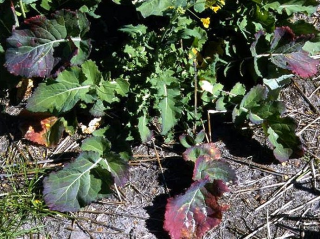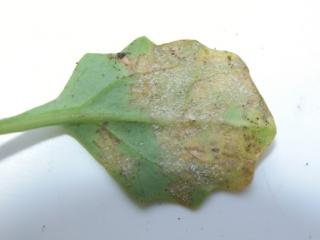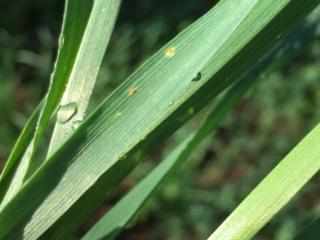Beet western yellow virus in canola
- Katanning
- Tambellup

Purpling of leaves and mottled looking canola at two locations in Katanning and Tambellup prompted an agronomist to take samples and send leaves to the department’s Diagnostic Laboratory Services (DDLS) for virus testing. The canola was sown in March at both locations and the canola at both locations was adjacent to a neighbours’ paddock that had unsprayed volunteer canola over summer. The crops are now at the big bud growth stage with some flowering. Turnip aphids and cabbage aphids were also found in high numbers with a few green peach aphids (GPA).
Virus testing by the department’s DDLS found that the Katanning canola crop had 5-10% beet western yellow virus (BWYV) infection around the beginning of bolting. This is likely to only result in less than 10% yield loss. However, further seed yield and quality losses are possible if rapid BWYV spread occurs in July from widespread proliferation of GPA colonies.
There are still visible numbers of GPA, turnip and cabbage aphid in the crop. The cooler weather is expected to decrease the aphid build up and some aphids have been found with fungal infections and some have been parasitised.
BWYV is an aphid-borne virus that causes yield and quality losses in canola crops. It also infects other crop and pasture species including mustard, chickpea, faba bean, field pea, lucerne, medic and subterranean clover. BWYV is found widespread throughout the Wheatbelt.
BWYV infection causes reddening, purpling or yellowing of the lower leaves of canola plants. Plants infected early (well before flowering) are often pale and stunted and these plants produce few flowers or seeds. Symptoms are milder and stunting is lacking with late infection. Leaf symptom type and severity differ depending on plant age at infection, environmental conditions and the canola variety involved. Symptoms of BWYV in canola can be confused with those caused by nutrient deficiencies, waterlogging or other plant stresses that cause yellowing, reddening or purpling of lower leaves.
BWYV is not seed-borne and survives from one growing season to the next in over-summering canola, broadleaf weed species, perennial legume pastures and some native plants. BWYV is spread by several aphid species that colonise canola including its principle vector, the green peach aphid and the minor vector, the cabbage aphid.
The virus infects phloem cells in a plants’ vascular system but not its other tissues. BWYV is transmitted persistently, that is, once an aphid feeds on the phloem cells of an infected plant the aphid acquires the virus. When the infective aphid then probes the phloem of a healthy plant it infects that plant. The aphid continues transmitting BWYV for the rest of its life so can infect many more healthy plants.
From previous field trials done by the department, when canola plants became infected very early (flowering) and the BWYV incidence in crops reached 96-100%, overall seed yield losses were up to 46%. For every 1% increase in the level of BWYV in a canola crop, there was a 6-12kg/ha decline in yield resulting from formation of fewer seeds. BWYV infection diminished seed quality by decreasing oil content (up to 3%) and increasing erucic acid (up to 44%). If the crop becomes infected late (podding), spread was much less and yield and quality losses were minimal.
BWYV spread can be controlled by insecticides including seed dressings and foliar spray but care must be used to avoid development of sulfoxaflor and imidacloprid resistance in green peach aphids from unnecessary or inappropriate use of these chemicals.
For more information on BWYV see the department’s Diagnosing beet western yellow virus in canola page.
For further information contact Ben Congdon, Research Officer, South Perth on +61 (0)8 9368 3499.
Canola downy mildew is widespread
Canola downy mildew appears to be widespread this season with recent sightings at;
- Wagin
- Cunderdin
- Collie
- Kojonup
- Katanning
- Williams
- Kendenup
- South Stirling


David Peake (Bayer Crop Science) reports that downy mildew is affecting some canola crops in Wagin and Kojonup.
James Easton (CSBP) reports finding downy mildew in a canola crop near Cunderdin. The plants were at the 4-5 leaf stage with the bottom two leaves showing symptoms.
Nathan Moyes (MoyesAgri) broadly reports finding downy mildew in canola anywhere in the great southern and central wheatbelt where there has been no or poor fungicidal seed coverage in paddocks. This area includes Collie and Kojonup.
Agriculture and food plant pathologist Ravjit Khangura has observed downy mildew in several crops in the Great Southern region, including Kendenup and South Stirling.
Ravjit says that the disease mainly affects young cotyledons, true leaves and expanded leaves, however the latter are usually less severely affected.
Symptoms of downy mildew typically appear as yellowed cotyledons and lower leaves. Older leaves display angular yellow lesions on the upper leaf surface. Sometimes the lesions appear as creamish, circular to irregular spots of varying sizes on the upper leaf surface that turn brownish over time. Examination of the underside of these leaves often shows a corresponding patch of white fluffy growth, although this can become less apparent with age. Severely affected cotyledons shrivel up and senesce prematurely.
While some early seedling mortality may occur, canola plants usually overcome the disease once they reach the cabbage stage. Infected plants will exhibit slower growth earlier in the season due to a combination of cold weather and presence of disease. Plants grow away from disease as they get older and as the weather warms up during spring.
Disease is generally favoured by cool wet conditions coupled with high humidity. However, this season despite dry conditions downy mildew pathogen appear to be more aggressive than previous years. This is probably due to milder temperatures.
Downy mildew is either soil borne, seed borne or requires a green bridge for carry over. Disease epidemics are sporadic, therefore developing control strategies against downy mildew can be very challenging.
Most of the current canola varieties are susceptible to downy mildew.
Only one copper based fungicide (Cung Fu 350SC®) is registered for downy mildew in canola and needs to be applied as per product label. Ravjit says her previous research on fungicidal control of downy mildew has shown that foliar fungicides are usually effective against downy mildew if applied before the onset of the disease. The economic benefit is unlikely if sprayed after severe infection. Fungicide seed dressings containing metalaxyl (MaximXL®) may provide some protection against downy mildew if the disease pressure is low to moderate.
More information about this disease can be found at the department’s Diagnosing downy mildew in canola page.
For more information contact Ravjit Khangura, Research Officer, South Perth on +61 (0)8 9368 3374.
Leaf rust in wheat
- Gairdner
James Bee (Elders) has found wheat leaf rust (WLR) in tillering Harper wheat near Gairdner on the south coast of WA. It was a widespread crop infection. James commented that he had observed several pustules on the older leaves on multiple plants in multiple paddocks across the farm. He had only observed WLR on this one farm which was growing Harper, Cobra and King Rock wheat varieties.
Growers and consultants are urged to check wheat crops for WLR and the likelihood of finding this disease will be greater if;
- Leaf rust was present in the area in 2016.
- Wheat volunteers, which may have carried over last season’s WLR inoculum, were present nearby in summer/autumn.
- A seed dressing or in-furrow fungicide with protection against WLR wasn’t applied.
- Wheat varieties sown are susceptible (S) to moderately susceptible (MS) to WLR. In this case Harper is rated moderately resistant moderately susceptible (MRMS#) to WLR as an adult, Cobra is rated moderately resistant (MR) and King Rock is rated MS#.
To find out the susceptibility of different wheat varieties visit the department’s latest wheat disease ratings page. It is important to note that with recent leaf rust incursions (2013 and 2015) the resistance of a variety can be dependent on the pathotype affecting the crop. Both pathotypes are present across the state. A rating with # indicates that the variety is potentially more susceptible to the newer pathotype.
When checking crops growers and consultants are also urged to look into the bottom of the canopy and stems for the presence of stem rust.
Agriculture and food plant pathologist Kith Jayasena says that in more susceptible varieties where leaf rust is present, it is important to halt the progression of disease. If rust is spreading through the crop it may be helpful to apply a foliar fungicide registered for leaf rust control at late tillering to stem extension, during post emergence weed control, to minimise leaf rust damage and limit further spread into other parts of the region.
If WLR is found growers and consultants are strongly urged to participate in the Australian cereal rust survey and submit samples to the University of Sydney, Private Bag 4011, Narellan, NSW 2567 for pathotype testing.
For fungicide information refer to the department’s Registered foliar fungicides for cereals in Western Australia page.
For more information on diagnosing and managing this disease refer to the department’s Diagnosing leaf rust of wheat and Managing stripe rust and leaf rust in wheat in Western Australia pages.
For more information contact Kithsiri Jayasena, Plant Pathologist, Albany on +61 (0)8 9892 8477, Geoff Thomas, Plant Pathologist, South Perth on +61 (0)8 9368 3262 or Andrea Hills, Plant Pathologist, Esperance on +61 (0)8 9083 1144.
Aphids, beneficial insects and slugs are in canola crops
- Belka
- Gorge Rock
- Newdegate
- Mount Barker
Andrew Crook (Farmer) has found turnip aphids in his early flowering Bonito canola crop near Belka.
Geoff Fisher (Farmer) has reported finding small populations of cabbage aphids in a Bonito canola crop near Gorge Rock. The crop had eight true leaves or more. Geoff has also reported finding green peach aphids (GPA) in his GT41 canola.
Nathan Moyes (MoyesAgri) reports finding GPA in a canola crop at Newdegate that has had patchy germination. The plants range in growth stage from cotyledon to four leaves. The GPA have caused plant death in 40-50 ha of a 200ha paddock.
Haydn Boetel (Student) has reported finding parasitised aphids in a six leaf canola crop near Mount Barker. This indicates that beneficial insects are present in the paddock. Haydn also reported finding a few patches of black-keeled slugs in the crop.
Canola crops that are moisture stressed or patchy due to staggered germination and dry conditions will be more vulnerable to aphid and other insect pest damage.
Although above average daytime temperatures have been forecasted for winter, the forecasted cold night time temperatures should diminish pest populations and slow reproduction.
Growers and consultants should also consider beneficial insects and their role in keeping aphid populations down. For more information on beneficial insects refer to the department’s Know what beneficials look like in your crop page.
For more information on aphids refer the department’s recently published Protecting WA Crops Issue 3 newsletter Aphids – WA’s insect problem children.
For more information on canola aphids refer to the department’s Aphid management in canola crops page.
For a list of insecticides registered for use on insect pests in canola see the department’s Autumn winter insecticide guide 2017.
For more information contact Svetlana Micic, Research Officer, Albany on +61 (0)8 9892 8591 or Dustin Severtson, Development Officer, South Perth on +61 (0)8 9368 3249.



